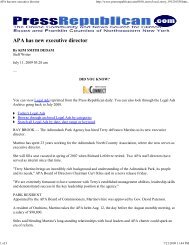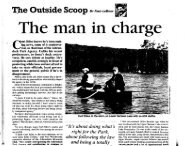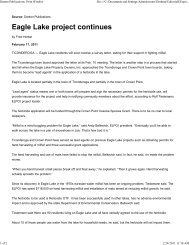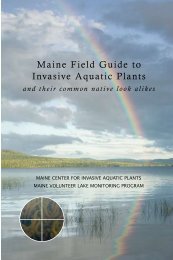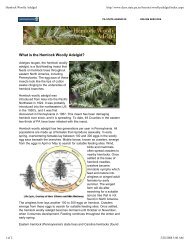Adirondack Park - Eagle Lake Property Owner's Inc.
Adirondack Park - Eagle Lake Property Owner's Inc.
Adirondack Park - Eagle Lake Property Owner's Inc.
Create successful ePaper yourself
Turn your PDF publications into a flip-book with our unique Google optimized e-Paper software.
causing even greater impacts. Some management activities, including education and outreach<br />
efforts, are ongoing for some of these species.<br />
The remaining eight priority species are not known to occur in the <strong>Adirondack</strong>s at this time.<br />
These include: hydrilla, an aggressive aquatic plant, quagga mussel, a relative of the zebra<br />
mussel, and fishhook and spiny waterflea, (two species of zooplankton). Priority fish species yet<br />
to reach the <strong>Park</strong> include: Eurasian ruffe, round goby, Asian carp (silver and bighead) and<br />
northern snakehead. All occur in either Great <strong>Lake</strong>s, Mid-Atlantic, or New England regions and<br />
have the potential to enter the <strong>Park</strong>. These species have caused significant negative impacts<br />
elsewhere and would likely do so in the <strong>Adirondack</strong>s. Spread prevention, including public<br />
education, is an ongoing high priority in order to keep these highly invasive species out of the<br />
<strong>Park</strong>.<br />
Following are descriptions of each of the eighteen high priority species of concern:<br />
Within the <strong>Adirondack</strong> <strong>Park</strong><br />
Purple loosestrife (Lythrum salicaria)<br />
Purple loosestrife, a perennial, wetland plant that spreads readily by seed has been locally<br />
common in marshes bordering <strong>Lake</strong> Champlain since at least 1929 (Muenscher, 1930). A native<br />
to Europe and Asia it likely advanced into <strong>Lake</strong> Champlain from the NY State Barge Canal<br />
where it had become established by the turn of the 19 th century (Thompson et. al., 1987).<br />
Accidental releases from ornamental stocks and transport in raw wool or on sheep may have also<br />
facilitated its spread into the Basin. Purple loosestrife infestations now occur in more than 171<br />
towns in Vermont (Copans and Garrity, 2003) and in an unknown, but considerable, amount of<br />
wetlands within the <strong>Lake</strong> Champlain Basin of New York and Quebec. Purple loosestrife outcompetes<br />
cattails and other native wetland plants and provides unsuitable habitat for a wide<br />
range of native wetland animals.<br />
In 2003, a researcher at SUNY-Plattsburgh, initiated a purple loosestrife biocontrol program in<br />
cooperation with Cornell Cooperative Extension, the Boquet River Association, and Master<br />
Gardener volunteers. The program is based on the culture and release of leaf-eating beetles<br />
(Galerucella spp.) with defoliating capabilities. They have released beetles at four sites in New<br />
York: Elizabethtown, Peru, Plattsburgh, and Wadhams. Staff and volunteers are conducting a 5-<br />
year post-release monitoring program to evaluate the effectiveness of the biocontrol program.<br />
Eurasian watermilfoil (Myriophyllum spicatum)<br />
Eurasian watermilfoil, a perennial, submersed aquatic plant native to Europe, Asia, and parts of<br />
Africa, was first discovered in New England in 1962 when it was reported in St. Albans Bay of<br />
<strong>Lake</strong> Champlain (Countryman, 1975). Now widely distributed throughout North America, the<br />
aquarium trade likely played a role in its initial introduction and spread (Couch and Nelson<br />
1985). A 1976 survey of <strong>Lake</strong> Champlain showed Eurasian watermilfoil present in all areas of<br />
the <strong>Lake</strong> and estimated that several thousand acres of the <strong>Lake</strong> were infested. (Countryman,<br />
1978). This species was also reported found in <strong>Eagle</strong> <strong>Lake</strong> in the late 1970’s. Eurasian<br />
watermilfoil continues to occupy an extensive range throughout the <strong>Lake</strong> and it infests at least 40<br />
other bodies of water throughout the <strong>Lake</strong> Champlain Basin, and much of the <strong>Adirondack</strong> <strong>Park</strong>.<br />
20





